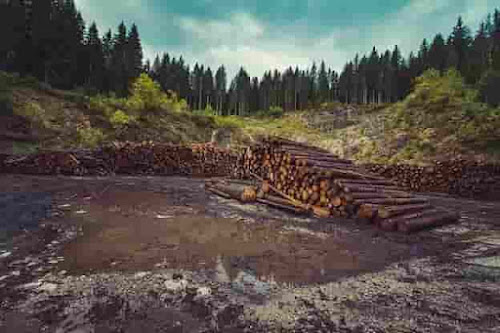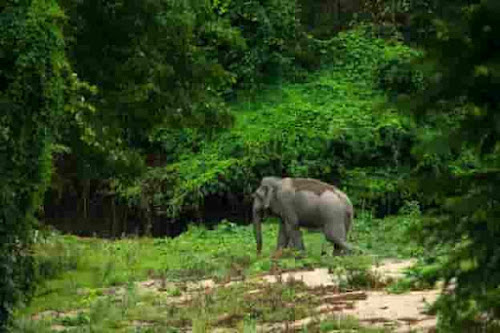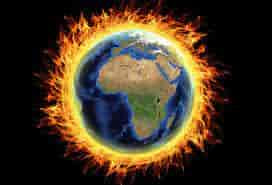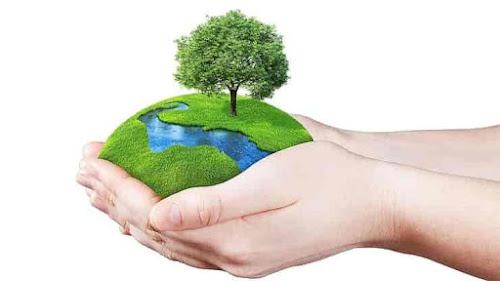Effects of Deforestation
Trees are our true friends. Trees give us oxygen to breathe, food to eat, life-giving medicines, cool shade, timber, fuel and many more. Forests are the homes for many animals as well as many indigenous people who are depending entirely on forests.

Deforestation
Deforestation is the removal of trees permanently by
cutting down, burning or destroying through intentional, natural or accidental
means. About 30% of earth land surface covered with forest but every year 3.5 7
billion trees cut down. Forests are called the lungs of the earth. About 87% of
deforestation occurs in tropical rain forest which is an alarming bell for
global environment.
Amazon, Borneo, Congo Basin and the Russian Far East,
where the deforestation is most severe.
Causes of Deforestation

Multiple factors cause deforestation. It can be
man-made or natural. Natural causes include storm, flood, wildfire,
parasite-caused diseases. But the human’s greed and selfishness are the main
causes of global deforestation.
Human activities such as agricultural expansion,
cattle breeding, timber, mining, oil, urbanization, infrastructure development
etc.
Agriculture causes 80% of deforestation, according to
the Food and Agriculture Organization (FAO). Deforestation is most common in
topical areas where the farmers used “slash-and-burn farming” cultivation
method in which the farmers burn the forest to clear the areas for growing
crops. After few years the soil losses its fertility and ability to grow crops.
Then the farmers move to the new areas of the forest and perform the same
practices. 33% of agricultural
deforestation is the result of subsistence agriculture.
About 40% of forests are destroyed for commercial or
industrial agriculture. These forest areas are cleared to grow food crops like
rice, maize, soybean; fibres like cotton; biofuels like palm oil etc.
About 7200 square miles of Brazilian rainforests has
burned which is as same as in size of New Jersey. In the Amazon, more than
80,000 fires burned as of August 2019, which is an increase of nearly 80% from
2018.
Between 1990 and 2000, over 10,000 square miles of
forests cut down to convert the areas into cropland for soy or grazing for
cattle.
Livestock ranching is another cause of deforestation.
About 14% of deforestation occurs due to livestock ranching. Brazil, a top exporter of beef has lost an
area of forest which is as same as the size of three-fourth of Texas.
Wood is used to
make paper, match sticks, furniture etc. The wood-base industries need a huge
supply of wood so trees are chopped.
Mining requires a forest land so trees are destroyed
to get the land. About 640 million trees are cutting down to make paper,
according to Environment Paper Network.
With the rapid growth of population, the people clear
the forests to make their homes, build roads, dams and other constructions. Infrastructures- transportation,
transformation and energy generation, are responsible for 10% to 12% of
deforestation.
Every year due to extreme summer or middle winter
thousands of trees are lost due to forest fire. In some places, the people cut
the trees to get the fire wood as fuel.
Deforestation affects the biodiversity. Deforestation
brings many problems like soil erosion, greenhouse gas emission, climate
change, loss of habitat, flooding, water cycle disruption, fewer crops and many
more.
Effects of Deforestation

Deforestation affects the biodiversity. Deforestation
brings many problems like soil erosion, greenhouse gas emission, climate
change, loss of habitat, flooding, water cycle disruption, fewer crops and many
more.
Soil Erosion and Flooding
The roots of the trees bind the soil and prevent it to
wash away. Topsoil is fertile and contains high organic matter. When the
forests are cut down, the raindrops fall directly on the bare soil surface and
can break down soil aggregates. The lighter aggregate materials are easily
washed away. Due to soil erosion, the soil loss its fertility, result fewer
crops or the land turns into fallow land and leads to downstream flooding.
The fine soil particles are carried by strong wind
which fill the river beds and shrink the channels. The rivers cannot handle the
load of water to carry and become overflow, result flood. The huge Yangtze
River flood of 1998 was occurred due to the deforestation. Trees can reduce the speed of the wind and
protect the soil from being blown away by the wind. So deforestation is one of
the main causes of soil erosion and flooding. Tree roots provide a mechanical
stabilization in slopes which prevent the land slopping. Flood and mudslides devastate
homes and communities.
Habitat loss

31% of earth surface is covered with forests which is the home of 80% of world’s known animals and plants. These forests give
shelter, food, water, protection and breeding habitat to the animals that live
in the forests. Tropical forest is the home of about half of all the earth’s
animal species.
Amazon rain
forest is the home of 40,000 plant species, 3000 freshwater fish species and
more than 370 types of reptiles.
Forests are the homes of 250 million people worldwide and 1.6 billion people are depended on the forests for their livelihood. Froests are the homes of about 60 million tribal and indigenous people who are totally dependent on forests for their livelihood and income.
Forest areas are decreases due to deforestation so the
animals do not get sufficient food and water, breeding habitat, shelter.
Deforestation pushes them towards extinction. Due to deforestation, many
animals that live in the forest become endangered like orangutans, giant
pandas, rhinos and the Asian elephants are some of endangered species. A recent
study of the Brazilian Amazon predicts that, in the next 40 years, 90% of
animals will be extinct.
Trees protect the forest areas from the scorching heat
of the sun like a huge umbrella. But lack of trees do not able to block the
sun’s ray during the day time and retains heat at night, which increase the
temperature that can be harmful for plants and animals.
Due to deforestation, about 28,000 animal species will
become extinct by the next quarter of the century.
Greenhouse gas emission and global warming

In the day time, the trees absorb carbon dioxide from
the air and release oxygen into the air during photosynthesis. At night, the
trees breathe out a small quantity of carbon dioxide during respiration. The
extra carbon dioxide is stored into the trees as carbon. When the trees burn,
the stored carbon dioxide get released into the air again. deforestation is one of the causes of increasing the carbon dioxide in the environment. Carbon dioxide is a
greenhouse gas, which trap the heat of the sun and prevent the heat from the
earth to radiate back into the space, result raising the atmospheric
temperature. Increasing of earth’s average temperature is called globalwarming.
A number of serious consequences happen due to global
warming such as melting glaciers, rise of sea-level, climate change, infectious
diseases, flooding, drought, hot waves, sever precipitation like hurricanes,
wildfires, pollution and many more.
Global warming can destroy the habitat of many flora and fauna and may lead to
extinction of many species.
Deforestation is responsible of 25% of the total
greenhouse gas production.
Climate Change
Deforestation is the second main cause of climate
change. The trees play an
important role to control global warming by utilizes the greenhouse gases. Due
to deforestation, the level of carbon dioxide is increasing in the atmosphere
dramatically which is one of the greenhouse gases that trap the sun’s heat and
increases the temperature of earth, as a result climate change progress.
Climate change is having serious impact on environment.
Climate change affect the weather phenomena, droughts, flood, forest fire,
death or extinction of many species of flora and fauna, hurricanes, hot waves,
Arctic likely to become ice-free, in one word climate change affects the whole
ecosystem.
Water Cycle
The forest especially rainforests store a huge
quantity of water. The trees and other vegetation play an important role in the
water cycle. The trees and plants absorb the underground water and evaporate
the water into the atmosphere. When the trees are destroyed or deforested, the
rainfall is reduced and the water cycle is interrupted, which leads to much
drier climate, drier soil and inability to grow crops. Gradually, the areas
become barren desert. Water cycle, due to deforestation, affects the ecosystem,
economies and our daily lives.
Three-fourth of earth’s fresh water comes from forested
watershed, according to 2018 report. Over half the global population depends on
this water for drinking and using this water for agriculture and industries or
other uses. So less of trees affect the water quality.
Nutrient Cycle
Deforestation affect the nutrient cycle. About 80% of
the nutrients in the rain forest come from trees and plants, which leaves 20%
nutrients in the soil. These nutrients recycled back into the plants and trees.
But deforestation changes this condition quickly. Dried soil, soil erosion
occurs which make the soil infertile. Soil becomes infertile when clear the
forested areas by grazing.
Effects on Human Health
The shady forests prevent the sunlight to enter the
forest floor, but the lack of trees due to deforestation increases the
temperature which can aid mosquitoes breeding. Plasmodium parasite transmitted
by mosquitoes which is the cause of malaria and every year over one million
people die due to malaria.
Water Pollution
For mining
activities, forested areas are cleared by deforested the trees. Gold mining
activities in the forested areas lead to water pollution. To separate gold from
the ground, mercury is used which washed away into the rivers or nearby water
bodies and polluted the water. The aquatic animals die and the people who live
nearby the areas also affected by this poisonous chemical.
30% of emerging diseases occur due to deforestation,
according to the World Economy Forum. Deforestation brings worrisome
life-threatening diseases, such as malaria, dengue, yellow fever etc.
Burning of trees increase the carbon dioxide into the
air, which is harmful for human health. Deforestation creates the conditions
for deadly pathogens to spread to people i.e. Nipah and Lassa viruses.

Trees protect our environment in several ways.
According to World Wildlife Fund, 30% of the earth’s land surface covers with
forests. These forests provide food and fuel to one billion people; jobs in the
forest sectors to 13.4 million people and also provide jobs related to forest
to 41 million people. Deforestation is leading the earth to destruction.
Planting more trees can save our earth. The action must be taken to stop
deforestation and have to try to repair the previous damage that has been
caused for more than hundred years.
Increase public awareness and influence people by educating them about the causes and effects of deforestation.


.jpg)














0 Comentarios:
Post a Comment
Please do not use any abusing words or enter any spam links in the comment box